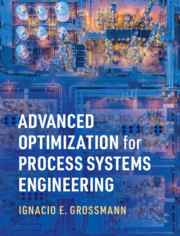Refine search
Actions for selected content:
36807 results in Cambridge Textbooks
6 - Time and Soil Processes
-
- Book:
- Introduction to the Biogeochemistry of Soils
- Published online:
- 09 September 2021
- Print publication:
- 17 June 2021, pp 101-114
-
- Chapter
- Export citation
References
-
- Book:
- Computer Age Statistical Inference, Student Edition
- Published online:
- 26 October 2021
- Print publication:
- 17 June 2021, pp 469-478
-
- Chapter
- Export citation
10 - Humans and Soil Biogeochemistry
-
- Book:
- Introduction to the Biogeochemistry of Soils
- Published online:
- 09 September 2021
- Print publication:
- 17 June 2021, pp 176-201
-
- Chapter
- Export citation
10 - Element Locking
-
- Book:
- Finite Element Method for Solids and Structures
- Published online:
- 08 July 2021
- Print publication:
- 17 June 2021, pp 266-282
-
- Chapter
- Export citation
2 - Truss, Temperature Effect, and Torsion
-
- Book:
- Finite Element Method for Solids and Structures
- Published online:
- 08 July 2021
- Print publication:
- 17 June 2021, pp 42-68
-
- Chapter
- Export citation
Frontmatter
-
- Book:
- Computer Age Statistical Inference, Student Edition
- Published online:
- 26 October 2021
- Print publication:
- 17 June 2021, pp i-vi
-
- Chapter
- Export citation
Index
-
- Book:
- Finite Element Method for Solids and Structures
- Published online:
- 08 July 2021
- Print publication:
- 17 June 2021, pp 348-352
-
- Chapter
- Export citation
4 - Structural Dynamics
-
- Book:
- Finite Element Method for Solids and Structures
- Published online:
- 08 July 2021
- Print publication:
- 17 June 2021, pp 111-137
-
- Chapter
- Export citation
12 - Cross-Validation and Cp Estimates of Prediction Error
- from Part II - Early Computer-Age Methods
-
- Book:
- Computer Age Statistical Inference, Student Edition
- Published online:
- 26 October 2021
- Print publication:
- 17 June 2021, pp 217-242
-
- Chapter
- Export citation
10 - The Jackknife and the Bootstrap
- from Part II - Early Computer-Age Methods
-
- Book:
- Computer Age Statistical Inference, Student Edition
- Published online:
- 26 October 2021
- Print publication:
- 17 June 2021, pp 163-188
-
- Chapter
- Export citation
15 - Large-Scale Hypothesis Testing and FDRs
- from Part III - Twenty-First-Century Topics
-
- Book:
- Computer Age Statistical Inference, Student Edition
- Published online:
- 26 October 2021
- Print publication:
- 17 June 2021, pp 281-307
-
- Chapter
- Export citation
16 - Sparse Modeling and the Lasso
- from Part III - Twenty-First-Century Topics
-
- Book:
- Computer Age Statistical Inference, Student Edition
- Published online:
- 26 October 2021
- Print publication:
- 17 June 2021, pp 308-334
-
- Chapter
- Export citation
Appendix 2 - Solution Methods
-
- Book:
- Finite Element Method for Solids and Structures
- Published online:
- 08 July 2021
- Print publication:
- 17 June 2021, pp 337-343
-
- Chapter
- Export citation
Part III - Twenty-First-Century Topics
-
- Book:
- Computer Age Statistical Inference, Student Edition
- Published online:
- 26 October 2021
- Print publication:
- 17 June 2021, pp 279-280
-
- Chapter
- Export citation
Appendix 1 - Fundamentals of Solid and Structural Mechanics
-
- Book:
- Finite Element Method for Solids and Structures
- Published online:
- 08 July 2021
- Print publication:
- 17 June 2021, pp 317-336
-
- Chapter
- Export citation
9 - Survival Analysis and the EM Algorithm
- from Part II - Early Computer-Age Methods
-
- Book:
- Computer Age Statistical Inference, Student Edition
- Published online:
- 26 October 2021
- Print publication:
- 17 June 2021, pp 138-162
-
- Chapter
- Export citation
20 - Inference After Model Selection
- from Part III - Twenty-First-Century Topics
-
- Book:
- Computer Age Statistical Inference, Student Edition
- Published online:
- 26 October 2021
- Print publication:
- 17 June 2021, pp 407-434
-
- Chapter
- Export citation
21 - Empirical Bayes Estimation Strategies
- from Part III - Twenty-First-Century Topics
-
- Book:
- Computer Age Statistical Inference, Student Edition
- Published online:
- 26 October 2021
- Print publication:
- 17 June 2021, pp 435-460
-
- Chapter
- Export citation

Advanced Optimization for Process Systems Engineering
-
- Published online:
- 11 June 2021
- Print publication:
- 25 March 2021
-
- Textbook
- Export citation
Frontmatter
-
- Book:
- An R Companion for the Third Edition of The Fundamentals of Political Science Research
- Published online:
- 25 June 2021
- Print publication:
- 10 June 2021, pp i-iv
-
- Chapter
- Export citation
